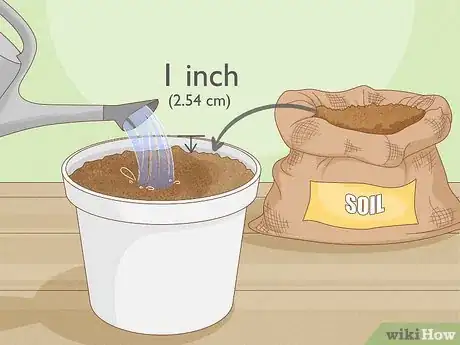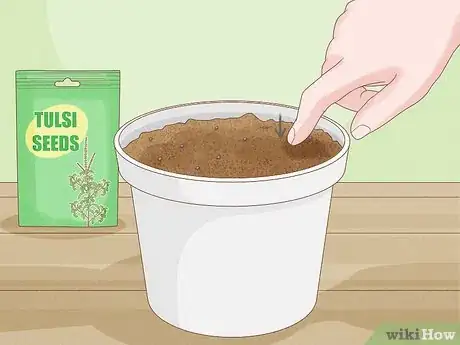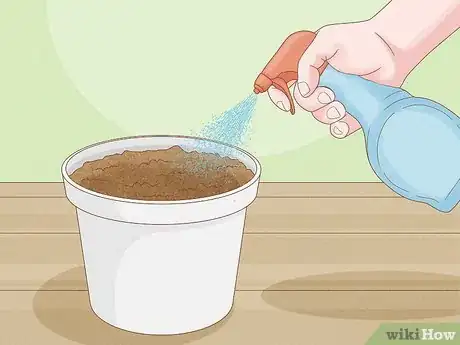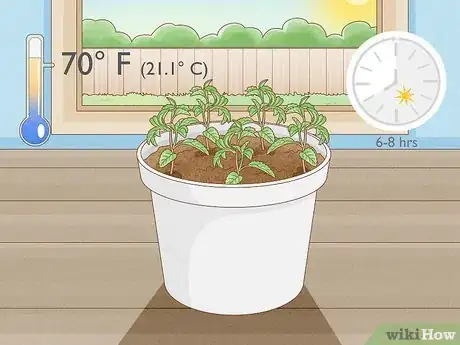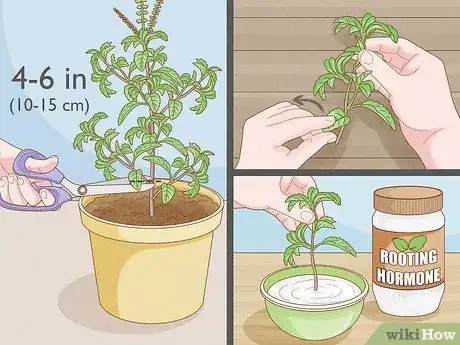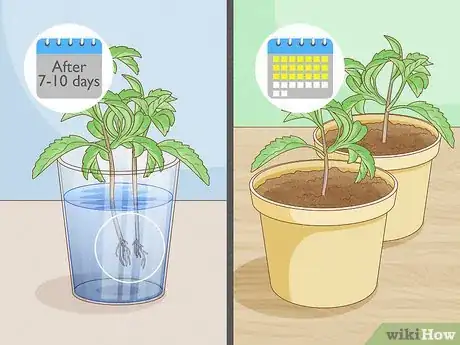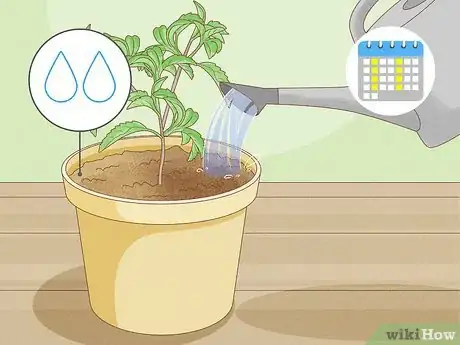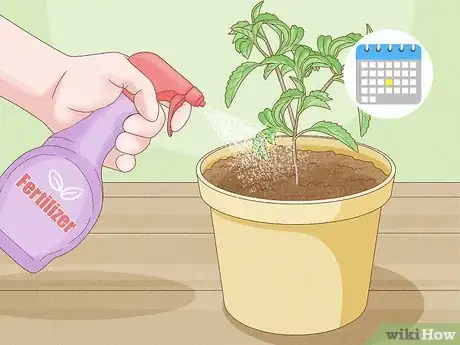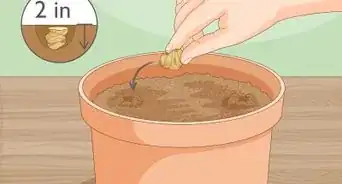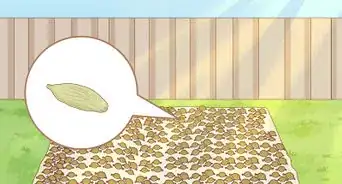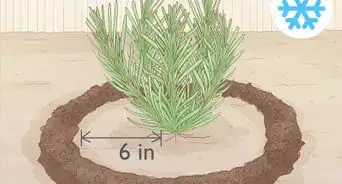This article was co-authored by Lauren Kurtz. Lauren Kurtz is a Naturalist and Horticultural Specialist. Lauren has worked for Aurora, Colorado managing the Water-Wise Garden at Aurora Municipal Center for the Water Conservation Department. She earned a BA in Environmental and Sustainability Studies from Western Michigan University in 2014.
There are 7 references cited in this article, which can be found at the bottom of the page.
This article has been viewed 146,654 times.
Also known as Holy Basil, this beautiful plant is often used as a medicinal herb to treat a wide range of ailments, from curing headaches to fighting cancer. The plant is easy to grow from seeds or by rooting in water and is really simple to take care of. You can keep it potted inside, or plant it outdoors in your ornamental or vegetable garden!
Steps
Growing Tulsi from Seeds
-
1Fill a flower pot with high quality soil and water it thoroughly. You should leave about an inch (2.54 cm) of space at the top of the pot. Add enough water to make the soil very moist, but don’t add too much water, because you don’t want the soil to be soggy.
- Even if you plan to plant your tulsi in an outdoor area, it's best to start growing it indoors before transferring to an outdoor bed.[1]
-
2Sow the seeds ¼ inch (0.64 cm) beneath the soil. Because tulsi seeds are so small simply sprinkle the seeds on top of the soil, then gently press them down into the surface using your fingers or a small tamper.Advertisement
-
3Keep the soil moist until the seeds germinate. The seeds will begin to grow in about 1-2 weeks. Because the seeds are so delicate, try using a spray bottle to lightly mist the surface of the soil. If you are pouring water into the pot, do so slowly and carefully so you don’t disrupt the seeds.
- Covering the top of the flower pot with plastic wrap will help seal in moisture, but you will still need to check the soil and add more water if needed.[2]
-
4Place the tulsi near a warm, sunny window. Your plant requires 6-8 hours of sunlight a day and temperatures of at least 70 °F (21 °C). Set the pot in an area where it can receive plenty of indirect sunlight.[3]
- Be careful not to leave the plant near open windows or doors if the temperature cools down overnight.
Rooting Tulsi in Water
-
1Cut a 4-6 inch (10-15 cm) stem from a mature tulsi plant. Remove the stem right below a set of leaves. Pluck all the other leaves from the bottom portion of your cutting. You’ll want to leave about 2 inches (5.1 cm) of the stem completely bare. [4]
- When cutting the stem, be sure to select one that hasn’t flowered yet. You can take a cutting from a flowering stem, but it will be more difficult to root and makes it more difficult for the plant.[5]
- Dip the cut end into a rooting hormone to speed up the process. Rooting hormones can be purchased at local nurseries or gardening stores.
-
2Place the tulsi cutting in a glass container filled with water. Use a clear drinking glass or a mason jar and fill it with enough water to cover just the bottom half of the stems. You can place more than 1 stem in the container, just be sure it is not overcrowded.
- Change the water every day so the stems don’t rot from an overgrowth of bacteria.[6]
-
3Put your tulsi plant in a warm, sunny spot. Choose a windowsill or table that will allow the plant to get at least 6-8 hours of bright, indirect sunlight.
-
4Transfer the cuttings to a pot of soil when the roots begin to grow. Your cutting will be ready to transfer to the soil when its roots are 1⁄4–1⁄2 inch (0.64–1.27 cm) long. It can take between 7 and 10 days to reach this point.
- If you have multiple cuttings in the container, pull them apart gently to avoid breaking the delicate roots.
- Keep the tulsi in the potted soil for 2-3 weeks before planting outdoors if you choose to.
Caring for Your Tulsi Plant
-
1Water your tulsi when the top layer of soil becomes dry. You should check your plant at least twice a week to see if it needs to be watered. If the top of the soil is dry, water it.[7]
- How often you need to water the plant will vary depending on the temperature and climate.
-
2Fertilize your plant once a month. Use a liquid fertilizer or organic compost, such as cow manure, to maintain the nutrients in the soil. An application once a month will help your plant continue to thrive.[8]
-
3Prune the tops of the tulsi weekly to encourage growth. Once your tulsi has 3 sets of leaves on a stem—1 at the top and 2 on the sides—you can begin pruning. Cut off the top set of leaves, just above the other 2 sets of leaves.[9]
- Pruning your tulsi helps it to grow faster and produce fuller branches.
-
4Transplant your tulsi once it has outgrown its pot. Once you notice the roots growing out of the drainage holes in the bottom of the pot, it’s time to transfer the plant to a larger pot. Depending on the size of pot you used to start, you may need to do this a couple of times.
- Keep in mind that the tulsi plant can grow up to 3 feet (0.91 m) tall, so be sure to plan for this when transferring either to a larger pot or outside.[10]
- You can safely transfer tulsi outdoors about 6-8 weeks after you planted it. Just be sure there is no risk of frost and that temperatures will be at least 70 °F (21 °C).[11]
Community Q&A
-
QuestionHow long does it take tulsi to grow?
 wikiHow Staff EditorThis answer was written by one of our trained team of researchers who validated it for accuracy and comprehensiveness.
wikiHow Staff EditorThis answer was written by one of our trained team of researchers who validated it for accuracy and comprehensiveness.
Staff Answer wikiHow Staff EditorStaff AnswerThe tulsi plant will germinate about 2 weeks after you plant the seeds, and will grow its first set of true leaves 2-3 weeks later. The plants should be ready for transplant another 2-3 weeks after that.
wikiHow Staff EditorStaff AnswerThe tulsi plant will germinate about 2 weeks after you plant the seeds, and will grow its first set of true leaves 2-3 weeks later. The plants should be ready for transplant another 2-3 weeks after that. -
QuestionWhy don’t we water tulsi on Sundays?
 wikiHow Staff EditorThis answer was written by one of our trained team of researchers who validated it for accuracy and comprehensiveness.
wikiHow Staff EditorThis answer was written by one of our trained team of researchers who validated it for accuracy and comprehensiveness.
Staff Answer wikiHow Staff EditorStaff AnswerIn Hinduism, the tulsi is a sacred plant. Certain days are especially sacred to the tulsi plant, including Sundays. Plucking the leaves is forbidden on Sundays, and some practitioners of Hinduism believe that the plant shouldn’t be disturbed at all on that day—even to water it.
wikiHow Staff EditorStaff AnswerIn Hinduism, the tulsi is a sacred plant. Certain days are especially sacred to the tulsi plant, including Sundays. Plucking the leaves is forbidden on Sundays, and some practitioners of Hinduism believe that the plant shouldn’t be disturbed at all on that day—even to water it. -
QuestionWhich day should you plant the tulsi plant at home?
 wikiHow Staff EditorThis answer was written by one of our trained team of researchers who validated it for accuracy and comprehensiveness.
wikiHow Staff EditorThis answer was written by one of our trained team of researchers who validated it for accuracy and comprehensiveness.
Staff Answer wikiHow Staff EditorStaff AnswerIn Hinduism, it’s considered especially auspicious to plant the tulsi during the months of Jeyshth (May-June) and Ashad (June-July). During those months, any auspicious day will work, such as the night of a full moon.
wikiHow Staff EditorStaff AnswerIn Hinduism, it’s considered especially auspicious to plant the tulsi during the months of Jeyshth (May-June) and Ashad (June-July). During those months, any auspicious day will work, such as the night of a full moon.
References
- ↑ http://www.agrifarming.in/tulsi-farming/
- ↑ http://www.finegardening.com/article/10-seed-starting-tips
- ↑ http://balconygardenweb.com/how-to-grow-tulsi-plant-care-and-growing-holy-basil/
- ↑ https://www.gardeningknowhow.com/edible/herbs/basil/propagating-basil.htm
- ↑ https://www.gardeningknowhow.com/edible/herbs/basil/propagating-basil.htm
- ↑ http://homeguides.sfgate.com/propagating-basil-stems-water-29939.html
- ↑ http://howtoculinaryherbgarden.com/grow-basil-from-seed-indoors/
- ↑ https://acegardener.com/gardening-tips/essential-tips-to-grow-tulsi/
- ↑ http://howtoculinaryherbgarden.com/grow-basil-from-seed-indoors/
About This Article
Tulsi is easy to grow at home and you don’t need any special equipment. You can grow tulsi in an ordinary flower pot with high-quality soil. Simply sprinkle the tiny seeds over the soil and use your fingertips to gently push the seeds ¼ inch below it. Then use a spray bottle filled with water to mist the seeds each day for 1-2 weeks, until they begin to germinate. You can also root tulsi in water. Cut a 4 - 6 inch stem from a mature tulsi plant and place the cutting in a glass filled with water. Then simply transfer the plant to soil when you can see the roots starting to grow. For more information about tulsi from our Horticulturist co-author, like how to care for it so that it thrives, read on.
